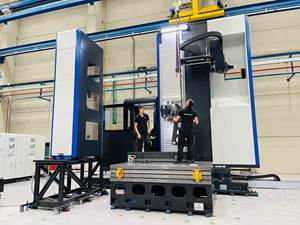MSI Mold Builders’ investment in five-axis machining at its Greenville, South Carolina location included not only a high speed machining center from Fidia, but also tool balancing equipment, a shrink-fit unit and a five-axis module for the shop’s CAM system. The investment also included one relatively simple consumer electronics item: a Web camera that the shop mounted inside the workzone of the machine.
This last item proved particularly useful to the multi-facility mold maker during the period when five-axis machining was still new in Greenville, and the shop was still becoming proficient.
MSI’s established five-axis capability was at its headquarters shop in Cedar Rapids, Iowa. In Greenville, Rick Geil would be the primary programmer and operator of the new machine. He visited Cedar Rapids for a week to learn about five-axis machining from the experienced users there. After he returned home, the Web camera made it easy for communication with Cedar Rapids to continue. Where there was a question about some detail of a five-axis job, Iowa could see the setup and movement of the machine via the Internet, and offer advice over the phone while watching. Thanks to the camera, Greenville was never left entirely alone with its new capability.
Video transmission over the Internet is finding more widespread use in machine shops. This is partly because an online video feed is so easy to set up and run, but it also reflects the fact that shops are seeking to do more with their staffing. When a shop has video monitoring, personnel who leave for the day can still look back. In some shops, CNC alarms can be sent via text message or e-mail. The recipient can then check the online video to size up the problem. Yet even in unattended processes that don’t have this messaging, and even in cases where the machining cycle proceeds without incident, the camera can still help minimize idle machine time. By checking in remotely to see how close a job is to completion, an operator can better time his or her return to the shop to switch out the work. MSI’s EDM operators in Iowa use Web cameras in just this way, staging the cameras on tripods to point at the machines’ control displays before leaving the machines to run unseen (but not entirely unseen).
In fact, this same benefit kept the Greenville camera valuable even after the shop had finished its five-axis learning curve. Mr. Geil used the camera to gage when long unattended mold milling cycles would be done. CAM systems can’t predict run time on these jobs with precision, he says, because the numerous complex axis moves include too many reversals and accelerations affecting cycle time. Therefore, he would check in on long milling jobs from home when he knew the end was getting close. Because he lives 15 minutes from work, glancing at the video let him time exactly when to walk out of his own door.
Video On Video
A new tutorial video on MMSOnline (see Editor Picks at right) discusses Web cameras in machine shop applications. In the video, two other shops—both of them mold shops as well—describe their own applications of shopfloor video monitoring. In New Freedom, Pennsylvania, Eden Tool uses cameras not just for checking unattended jobs remotely, but also for letting specialized customers see their molds being machined in real time, particularly medical device makers. Video monitoring is new at Eden Tool, and the MMS Online footage was able to capture and document the shop’s installation of this hardware.
Meanwhile, in Wake Forest, North Carolina, Superior Tooling turned to a security company to put in its own higher-end system for shopfloor monitoring. One of the most significant benefits the shop has realized is greater confidence to run unattended.
“There is always that uncertainty,” explains shop owner Robbie Earnhardt in the video—that is, uncertainly about hitting Cycle Start and walking away. The cameras reduce that “fear factor,” he says. Programmer and operator David Range says the camera “gives you that easy feeling where you can go to sleep at night,” because the online view makes it possible to put to rest—at a glance—any doubts about whether the machining cycle back at the shop is really proceeding as expected.
Taking a Quick Look
For MSI, having the camera in place allowed the feeling of confidence to extend across hundreds of miles. Tim Atwood, the company’s technology manager, is stationed in Iowa. During the period when five-axis machining was still new for South Carolina, he says, “I would sometimes just want to check on how they were doing.”
With the Internet camera, he could confirm in a few minutes that the five-axis capability was busy and being used effectively in the distant shop. This was similar to the way he might confirm the same thing about the five-axis capability in Cedar Rapids—though in the latter case, he would simply walk out to the shop floor.
In some ways, the Greenville view might be better. The camera there sits inside the machining area. It can even pan and zoom to see details. That’s how South Carolina would know when Iowa was watching, in fact—the camera would begin to move. Mr. Atwood admits, this effect might have been a little eerie sometimes.


.png;maxWidth=728;quality=90)


























